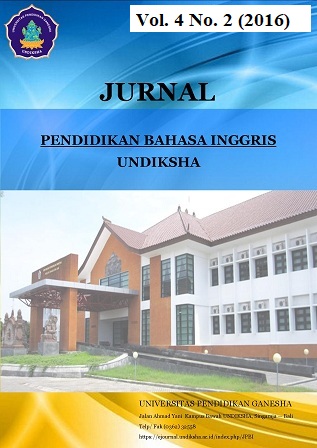THE EFFECT OF THE IMPLEMENTATION OF DICTOGLOSS TECHNIQUE ON LISTENING COMPREHENSION OF THE 10th GRADE STUDENTS OF SMA NEGERI 1 SUKASADA IN ACADEMIC YEAR OF 2016/2017
DOI:
https://doi.org/10.23887/jpbi.v4i2.9706Abstract
Penelitian ini bertujuan untuk menyelidiki apakah ada pengaruh yang signifikan pada penerapan teknik Dictogloss pada skor kemampuan mendengarkan siswa kelas sepuluh SMA Negeri 1 Sukasada. Desain penelitian yang digunakan adalah Post-test Only Control Group Design. Populasi penelitian ini adalah siswa kelas sepuluh SMA Negeri 1 Sukasada. Cluster Random Sampling diguanakan untuk memilih sampel penelitian. Sampel penelitian ini adalah 20 siswa pada kelas X3 untuk kelas eksperimen dan 21 siswa kelas X2 untuk kelas control. Kelompok eksperimen diajar dengan menggunakan teknik Dictogloss dan kelompok kontrol diajar dengan menggunakan teknik mengajar konvensional. Data dianalisis melalui uji t dengan menggunakan program SPSS. Hasil analisis data menunjukkan bahwa siswa dalam kelompok eksperimen lebih baik daripada siswa dalam kelompok kontrol. Hal ini dibuktikan oleh hasil statistik deskriptif yang menunjukkan nilai rata-rata dari kelompok eksperimen adalah 81,40 sedangkan nilai rata-rata dari kelompok kontrol adalah 78,24. Hasil uji-t juga menunjukkan bahwa nilai tobs lebih tinggi dari tcv. Nilai tobs adalah 2,185 sedangkan nilai tcv adalah 2,023. Ini berarti bahwa terdapat pengaruh yang signifikan pada kemampuan mendengarkan siswa yang diajar dengan menggunakan teknik Dictogloss dibandingkan dengan yang diajar dengan menggunakan teknik mengajar konvensional.Kata Kunci : Teknik Dictogloss, pemahaman mendengarkan, penerapan teknik Dictogloss.
This study aimed at investigating whether or not there was a significant effect of the implementation of Dictogloss technique upon listening comprehension of the tenth grade students of SMA Negeri 1 Sukasada. The research was an experimental one with Post-test Only Control Group Design. The population was the tenth grade students of SMA Negeri 1 Sukasada. Cluster Random Sampling was assigned to select the sample of the study. The samples were 20 students at grade X3 for experimental group and 21 at grade X2 for control group. The experimental group was taught by using Dictogloss technique and the control group was taught by using conventional teaching technique. The data was analyzed by using T-test through SPSS program. The result of the data analysis showed that students in experimental group performed better than the students in control group. It was proven by the result of the descriptive statistics that showed the mean score of the experimental group was 81.40 while the mean score of the control group was 78.24. The result of the t-test also showed that the value of the tobs was higher than the tcv. The value of the tobs was 2.185 while the value of the tcv was 2.023. It can be concluded that there was a significant effect on students’ listening achievement that were taught by using Dictogloss technique than were taught by using conventional teaching technique.
keyword : Dictogloss technique, listening comprehension, the implementation of Dictogloss technique.
Published
2017-03-02
Issue
Section
Articles
License
Authors who publish with the Jurnal Pendidikan Bahasa Inggris Undiksha agree to the following terms:- Authors retain copyright and grant the journal the right of first publication with the work simultaneously licensed under a Creative Commons Attribution License (CC BY-SA 4.0) that allows others to share the work with an acknowledgment of the work's authorship and initial publication in this journal
- Authors are able to enter into separate, additional contractual arrangements for the non-exclusive distribution of the journal's published version of the work (e.g., post it to an institutional repository or publish it in a book), with an acknowledgment of its initial publication in this journal.
- Authors are permitted and encouraged to post their work online (e.g., in institutional repositories or on their website) prior to and during the submission process, as it can lead to productive exchanges, as well as earlier and greater citation of published work. (See The Effect of Open Access)













